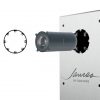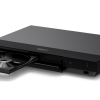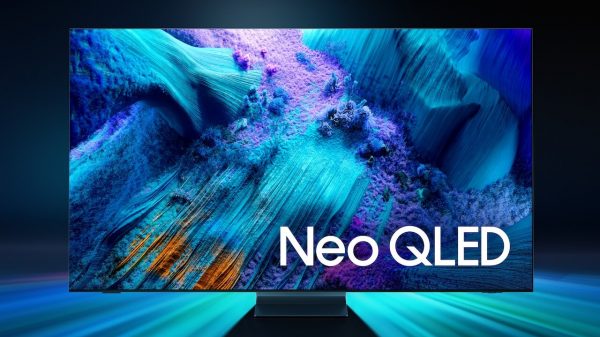Plasma TVs were discontinued in late 2014, but many consumers still favor the picture quality of a plasma TV over the now-dominant LCD TV and the ever-increasingly popular OLED TV.
How Plasma TV Works
Plasma TV technology is similar to that used in fluorescent light bulbs. The screen display panel consists of a layer of cells. Each cell has two glass panels separated by a narrow gap. Neon-xenon gas is injected and sealed in plasma form during manufacturing. When fed by electric current, the gas is charged at specific intervals. The charged gas strikes red, green, and blue phosphors. As a result, images are dislayed.

Sub-Field Drive
Plasma TV pixels are self-emissive. This means that the pixels generate their own light within a cell structure (no additional backlight source required), but they can only do so for a very brief period (milliseconds). However, sending electric pulses at a rapid speed to the pixels enables them to stay lit for the necessary time to display an image. This is done with a Sub-field drive.
Tip: OLED pixels are also self-emissive, but LCD pixels require a backlight to display images.

Sub-Field Drive Rate and Screen Refresh Rate
A screen refresh rate is how many times each frame is repeated within a specific time period, such as 1/60th of a second. Plasma TVs have a native 60Hz screen refresh rate, but in addition, they do something that smooths motion further. Using a Subfield drive, repeated electric pulses are sent to the pixels so they stay lit for the time each frame is displayed.
Since plasma TVs typically have a 60Hz screen refresh rate, if the sub-field drive sends 10 pulses to the pixels within a 60th of a second, the sub-field drive rate is stated as 600Hz.
The motion between each displayed frame will look smoother as more pulses are seen within the 60Hz refresh rate time period. As a result pixel brightness remains as constant as possible as successive frames are displayed.
Tip: A sub-field drive rate might be stated as 480Hz, 550Hz, 600Hz, or 700Hz.
Plasma TV History Highlights
Here are timeline highlights of the rise and fall of Plasma TV.
- 1964: Looking for a practical graphics display device that could be used for the education space, Donald Bitzer, Gene Slottow, a Professor at the University of Illinois, and graduate student Robert Wilson, invented the Plasma TV core technology.
- 1967: A 1-by-1-inch, 16 x16 pixel single color Plasma panel capable of producing a 1/2 x 1/2-inch image with a 1 hour address time was developed. Richard Lewis, of the Chicago Daily News Service, wrote a report on Plasma display technology, dubbing it the “Vision Plate”; and predicting that will someday replace CRT TVs (which ended up being partially true).

- 1971: First Plasma display for sale (Owens-Illinois). It featured a panel with a 512 x 512-pixel resolution and 12-inch diagonal monochrome (single color) screen.
- 1975: 1,000 monochrome Plasma graphic displays sold.
- 1978: Japan’s NHK broadcasting service demonstrates the first color Plasma display prototype (16-inch diagonal screen size with a 4×3 aspect ratio).
- 1983: IBM announces a monochrome Plasma graphic display with 960 x 768-pixel resolution for desktop computer use.
- 1989: The first use of monochrome Plasma displays in portable computers.
- 1992: Fujitsu introduces the first 640 x 480 21-inch color Plasma TV.
- 1996: Fujitsu announces a 42-inch Plasma TV with 852 x 480 pixel resolution.
- 1997: Pioneer announces first 50-inch Plasma TV with 1280 x 768 pixel resolution
- 1999: Plasmaco reveals a 60-inch Plasma TV prototype with 1366 x 768 pixel resolution.
- 2004: Samsung displays an 80-inch Plasma TV prototype at CES
- 2006: Panasonic announces a 103-inch 1080p Plasma TV. The initial price was $70,000, lowered to $50,000 after two years on the market.

- 2008: Panasonic announces 150-inch 4K Plasma TV at CES. However, Pioneer announces that it would end Plasma TV panel production by 2010

- 2010: Panasonic displays a 152-inch 4K/2K 3D Plasma TV Prototype.
- 2012: NHK/Panasonic show 145-inch 8K Super Hi-Vision Plasma TV Prototype.
- 2014: LG, Samsung, and Panasonic discontinue plasma TV production as LCD TVs continue to dominate the market, and OLED TVs begin to enter the TV market.
For a more detailed look at the Plasma TV timeline, refer to the PDF chart from SID (Society For Information Display).

Why Were Plasma TVs Discontinued?
Plasma TV has a special place in TV history. Although LCD and Plasma TVs were introduced around the same time, and both started the move away from “boxy” CRT TVs, LCD was able able to evolve and remain competitive in the long term and is still the dominant type of TV available. LED/LCD, QLED, Mini-LED, and NanoCell are all LCD-based TVs.
Plasma TV had a lot going for it in the beginning, such as the ability to display deep blacks, wide contrast range, exceptional color, and wide viewing angles that were, and many believe still are better than LCD-based TVs, but there were additional factors working against Plasma that led to its eventual downfall.
High Energy Consumption: Plasma TVs consume a lot of power, and with that generate heat. With some governments (such as California and the EU) beginning to tighten power consumption regulations for household appliances, Plasma TV makers had trouble meeting those requirements.
Poor Performance at High Altitudes: Changes in air pressure at higher altitudes (4,000 feet and above) affected the gas inside the cells. This resulted in an audible buzz which could be annoying.
Low Brightness: Plasma TVs are not bright when compared to their competition: LCD TVs. This was especially revealing in brightly lit retail showrooms. When placed next to an LCD TV, a Plasma TV looks dim. At the same time, they were great for use in dimly lit rooms, but they didn’t look bright in the store. As result consumers graduated to the TVs with the brighter picture.
Reflective Screen: The screen surface of a Plasma TV is very reflective. As a result, they were susceptible to glare from ambient light sources, more so than many LCD TVs.
Screen Burn-in: Plasma TVs are more vulnerable to burn-in of static images. This problem diminished over the years due to “pixel orbiting” and related technologies. However, just as with OLED, screen burn-in could still occur.
Limited Screen Sizes: Unlike LCD TVs, Plasma TVs were rarely available in screen sizes smaller than 42 inches (a few 32 and 37-inch Plasma TVs were made early on). This resulted in the loss of a large consumer base looking for smaller screen sizes for small apartments, bedrooms, offices, etc… LCD TV makers had no problem filling this category.
No 4K UHD: There are no 4K UHD Plasma TVs. Although both 4K and 8K UHD Plasma TV prototypes were demonstrated, none were finalized for the consumer market. Word is that due to the Plasma TV cell structure, production of 4K and 8K UHD models was just too expensive to bring to market.
Decreasing Sales: As LCD TVs improved with innovations such as LED backlighting, Full Array Local dimming, a wider variety of screen sizes, and the introduction of 4K UHD resolution displays, Plasma TVs were continuing to lose favor with consumers, resulting in decreasing sales, despite a strategic move by TV makers to lower prices.

Can You Still Find a Plasma TV?
Even though Plasma TVs have been discontinued, you may still be able to buy one used. If you find one with low-hour use, it may command a high price. Also, whenever you buy a used TV, if possible, try to see it in operation before you buy, but short of that, make sure the remote control, power cord, and user guides are all included.
Related Reading
Buying a New TV: Everything You Need To Know

















































ORT
November 27, 2022 at 2:56 am
My oldest brother still has a 50″ Plasma. It looks reeeeeeeeeeeeeeeeeeeeeeeeeeeeally good too! So good that I acquiesced to his demand to not give him a new 4K TV. n I cancelled delivery of the new 4K TV I was giving him and his wife as an early Christmas present.
I try not to use the word “gift” as it is German for “poison”. If you are ever on “Jeopardy” and they ax you that question. You can thank me later. If you want to.
In my case many of my elders were from Germany and so they would chastise me for, as they put it, “…scaring them into thinking I would give them poison for Christmas/Hanukkah/Chanukah/Festivus.
Actually, they no longer celebrate “Festivus” as I always won the Feats of Strength. Yup.
My older brother lives in Oregon so they also use it as a relatively inexpensive-to-run room heater…”Thank you! Thank you very much! I’m here ’til Thursday. Try the Kishka!”
Plasmas do tend to run very hot. Another interesting read form the WTF Series! Thank you, I really do enjoy these!
ORT